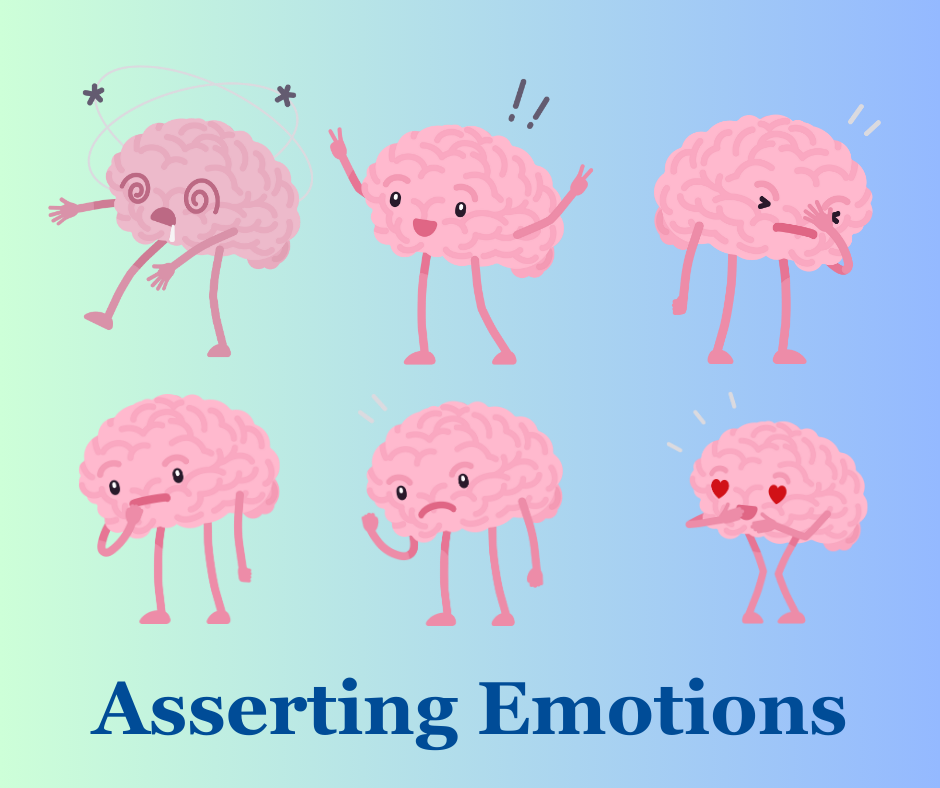
Asserting Emotions
Emotions play an important role, and have been the topic of scientific inquiry in psychology for well over a century (Cannon, 1927; Darwin, 1872; James, 1890).
Intrapersonal Functions of Emotions
Emotions are rapid information-processing systems that help us act with minimal thinking (Tooby & Cosmides, 2008). Problems associated with birth, war, and death have occurred throughout evolutionary history. Emotions evolved to help us adapt to problems rapidly and with minimal conscious cognitive effort. If we did not have emotions, we could not make rapid decisions concerning whether to attack, defend, flee, care for others, and so forth. For instance, the emotion of disgust helps us immediately take action by not ingesting rotten food. This response is adaptive because it aids, ultimately, in our survival and allows us to act immediately without much thinking. In some instances, taking the time to sit and rationally think about what to do, calculating cost–benefit ratios, is a luxury that might cost someone their life. Emotions evolved so that we can act without that depth of thinking.
Emotions Prepare the Body for Immediate Action
Emotions prepare us for behavior. When triggered, emotions orchestrate systems such as perception, attention, inference, learning, memory, goal choice, motivational priorities, physiological reactions, motor behaviors, and behavioral decision making (Cosmides & Tooby, 2000; Cosmides & Tooby, 2008). Emotions simultaneously activate certain systems and deactivate others in order to prevent the chaos of competing systems operating at the same time, allowing for a coordinated response to environmental stimuli (Levenson, 1999). For instance, when we are afraid, our bodies shut down temporarily unneeded digestive processes, resulting in saliva reduction (a dry mouth), blood flows disproportionately to the lower half of the body, the visual field expands; and air is breathed in, all preparing us to flee.
One common misunderstanding about emotions is the belief that emotions must always directly produce action. This is not true. Emotion certainly prepares the body for action; but whether people actually engage in an action is dependent upon many factors, such as the context, the target of the emotion, perceived consequences, previous experiences, and so forth (Baumeister, Vohs, DeWall, & Zang, 2007; Matsumoto & Wilson, 2008). Thus, emotions are just one of many determinants to behavior, albeit an important one.
Emotions Influence Thoughts
Emotions are also connected to thoughts and memories. Memories are not just facts that are encoded in our brains; they are colored with the emotions felt at the time when the memory occurred (Wang & Ross, 2007). Thus, emotions serve as the neural glue that connects those disparate facts in our minds. That is why it is easier to remember happy thoughts when cheerful, and angry times when upset. Emotions serve as the affective basis of many attitudes, values, and beliefs that we have about the world and the people around us. Without emotions, our attitudes, values, and beliefs would just be statements without meaning. The emotions give those statements meaning. Emotions influence our thinking processes, sometimes in constructive ways, and sometimes not. It is difficult to think critically and clearly when we feel intense emotions, and easier when we are not overwhelmed by our emotions (Matsumoto, Hirayama, & LeRoux, 2006).
Emotions Motivate Future Behaviors
Because emotions prepare our bodies for immediate action, our emotions will influence our thoughts, and motivate future behaviors. Many of us strive to experience satisfaction, joy, pride, or triumph in our accomplishments and achievements. At the same time, we avoid strong “negative” feelings. For example, once we have experienced disgust when drinking spoiled milk, we try to avoid experiencing those feelings again. We may check the expiration date on labels before buying milk and smelling the milk before drinking it. Emotions, therefore, not only influence immediate actions but also serve as an important motivational basis for future behaviors.
Interpersonal Functions of Emotion
Emotions are expressed both verbally and nonverbally. We are constantly expressing emotions during interactions, and others can reliably judge those emotional expressions (Elfenbein & Ambady, 2002; Matsumoto, 2001). Our emotions may influence others within our social interactions. Emotions communicate information about our feelings, intentions, and relationships. Because emotions have this communicative signal value, they help solve social problems by evoking responses from others via this signaling nature.
Emotional Expressions Facilitate Specific Behaviors in Perceivers
Because facial expressions are universal social signals, they contain meaning not only about a person’s psychological state but also about their intent and subsequent behavior. This information can affect another person’s actions. People observing fearful faces, for instance, are more likely to approach a person carefully, whereas people who observe angry faces are more likely to avoid approaching completely (Marsh, Ambady, & Kleck, 2005).
Asserting Your Emotions
Have you ever been so swept up in your emotions that you can’t think straight? Part of being assertive includes understanding and expressing your feelings, and not just what you want and need from others. Expressing our feelings can be challenging for a number of reasons.
David, S. (2018). The Gift and Power of Emotional Courage. Ted Talk. Retrieved from https://www.youtube.com/watch?v=NDQ1Mi5I4rg
Understanding and asserting our emotions is important and challenging work. Lisa Feldman Barrett is a Neuroscientist and Psychologist who also studies emotions. Her research helps us understand that we are in control of our emotions, an that they are not in control of us.
Barrett, L. (2018). You aren’t at the Mercy of your Emotions – your Brain Creates them. Ted Talk, Retrieved from https://www.youtube.com/watch?v=0gks6ceq4eQ

